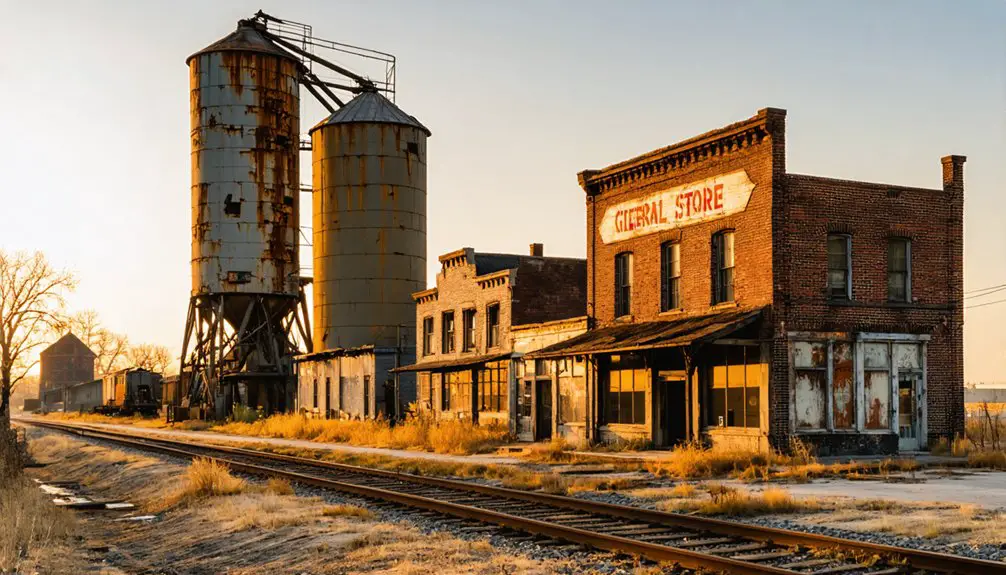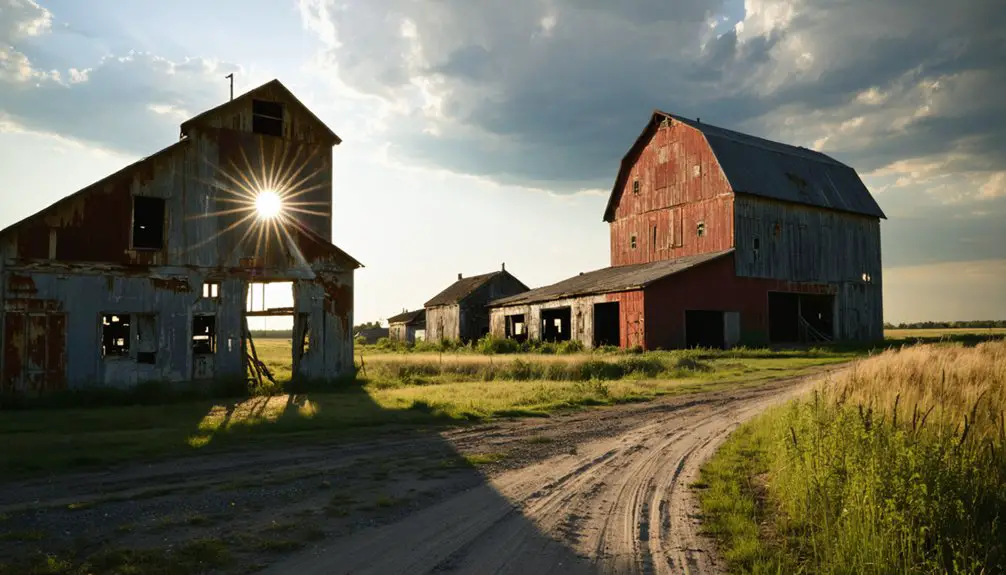You’ll find Pomme de Terre’s ghost town roots in its 1863 founding around a frontier fort, named by French traders for the prairie turnip (“apple of the earth”) abundant in the area. The settlement thrived through the 1870s with a grist mill, stores, and blacksmith shops before railroad bypasses triggered its decline. Today, you can explore the old schoolhouse and cemetery with 19th-century headstones – silent witnesses to a once-bustling pioneer community’s fascinating transformation.
Key Takeaways
- Pomme de Terre was a 19th-century Minnesota settlement named after prairie turnips, which became a ghost town after railroad expansion bypassed it.
- The town’s decline accelerated after an 1887 grain elevator fire, leading to merchant relocation and population loss.
- Railroad development in nearby towns caused higher transport costs for local farmers, contributing to the settlement’s economic downfall.
- The post office closure in 1902 marked a significant milestone in Pomme de Terre’s transformation into a ghost town.
- Today, only the old schoolhouse, a cemetery with 19th-century headstones, and historic markers remain as evidence of the former settlement.
The Origins Behind the French Name
While many assume Pomme de Terre refers to potatoes, the French name actually derives from the prairie turnip (Psoralea esculenta), an essential indigenous food source in the region.
You’ll find this French linguistic term, literally meaning “apple of the earth,” parallels similar naming patterns across multiple languages.
Early French fur traders named the area after observing the abundance of this important tuber, which the Dakota Sioux called “Tipsinah.” To avoid confusion with other locations sharing the name, the area requires specific disambiguation when referenced in historical records.
French trappers adopted local knowledge, naming the region for the abundant prairie turnip known as Tipsinah by Dakota peoples.
The indigenous significance of this root vegetable can’t be understated – it served as a staple food alongside buffalo meat for Plains tribes.
The name exemplifies how French explorers often incorporated local ecological knowledge into their place-naming practices, creating a lasting reflection of the blending of European and Native American influences in Minnesota’s geography.
The June ripening season was so culturally significant that the Lakota people named this month tinpsila itkahca wi after the breadroot plant.
Early Settlement and Frontier Life
You’d find the early pioneers of Pomme de Terre facing harsh daily challenges as they carved out homesteads and worked the land while hauling crops to distant markets like Herman and Alexandria.
The establishment of Fort Pomme de Terre in 1863, with its nine-foot stockade walls and strategic hilltop position, provided essential protection during the tense period following the Sioux Outbreak of 1862.
Life along the St. Cloud to Fort Abercrombie stage route brought a steady stream of travelers through the settlement, where the station served as both a military outpost and an important relay point for weary stagecoach passengers.
The settlers cultivated rich black loam soil that supported their farming endeavors and helped establish the region’s agricultural foundation.
The fort’s twelve military families lived alongside enlisted men in the barracks, creating a unique community within the defensive walls.
Pioneer Daily Hardships
Life in Pomme De Terre tested the limits of human endurance as pioneers faced a relentless cycle of physical demands and environmental challenges.
A simple corn diet sustained families through their grueling daily work.
Women struggled with mental health challenges from the isolation and constant toil of frontier life.
You’d find yourself working from dawn to dusk, clearing dense forest with axes and saws, breaking stubborn sod, and battling Minnesota’s extreme temperatures.
Pioneer resilience showed in every aspect of daily life – women spent nine hours on domestic labor while men mastered multiple survival skills from farming to hunting.
You couldn’t rely on doctors when illness struck, and you’d need to make everything from scratch – clothes, candles, bullets, and medicines.
Your survival depended on developing essential skills like fire-making and wheat threshing.
When times got tough, you’d turn to your neighbors, forming tight-knit communities where everyone pitched in for homebuilding and farming tasks.
Frontier Defense Challenges
The harsh realities of pioneer survival took on new urgency during the Dakota Uprising of 1862, when settlers needed more than just farming skills to protect their families.
You’ll find that Fort Pomme de Terre‘s fortification strategies reflected these dangerous times, with its 9-foot stockade walls carefully positioned on an oak-covered hill overlooking crucial water sources.
Supply line vulnerabilities meant constant vigilance was necessary. While the 8th Minnesota Volunteer Infantry maintained patrols, the fort’s isolated location left travelers exposed to ambush along the St. Cloud-Fort Abercrombie road.
The deaths of soldiers like Private Hair and Corporal Blackman highlighted the risks of venturing beyond the stockade. Despite these challenges, the fort’s timber blockhouse and strategic position helped safeguard essential communication routes between St. Paul and the Red River Valley.
Life Along Stage Route
Along Pomme de Terre’s bustling stage route, three crucial services formed the backbone of frontier mobility: regular mail delivery, passenger transport, and light freight hauling.
You’d find a mix of travelers, traders, and settlers moving through the stagecoach routes, stopping at the town’s strategically placed stations for fresh horses and repairs. The journey from St. Cloud typically took three full days to reach Fort Abercrombie.
Life along the route centered around these essential services:
- Blacksmiths and wheelwrights kept coaches and wagons rolling through all seasons.
- Innkeepers provided traveler accommodations, serving meals and offering basic lodging.
- Local farmers supplied hay, grain, and fresh produce to feed both travelers and horses.
- Merchants and craftspeople operated shops that served both the local community and those passing through.
These services transformed Pomme de Terre from a simple way station into a thriving frontier community, though its prosperity would later fade. The Sauk River route became a major transportation corridor, replacing older trails in the region.
Military History and Fort Pomme De Terre
Built during the tumultuous period of the U.S.-Dakota War, Fort Pomme de Terre emerged in 1863 as a critical military outpost under Captain Samuel McLarty’s Company D, 8th Minnesota Volunteer Infantry.
Fort Pomme de Terre stood as a vital stronghold in 1863, established by Union forces during the intense U.S.-Dakota conflict.
You’ll find that military engagements near the fort included the tragic May 2, 1863 ambush that claimed three soldiers’ lives. The fort’s construction followed Army directives, featuring a nine-foot bullet-proof stockade with east and south entrances and strategic blockhouse positions.
Within the stockade walls, you’d have seen a bustling military community complete with barracks, stables, and an officers’ house capable of housing 500 men. Operations were coordinated with Fort Ripley headquarters, which oversaw military campaigns in the region.
The fort’s garrison, consisting of Civil War veterans and exchanged prisoners, maintained essential supply routes between Alexandria and other regional posts while protecting settlers during this volatile frontier period.
Economic Growth and Commerce

During Pomme de Terre’s peak commercial period in the 1870s, you’d have found a bustling frontier economy anchored by essential businesses serving both settlers and travelers.
The town’s economic resilience centered on its strategic location along the St. Cloud to Fort Abercrombie stage route, where trade dynamics flourished through local commerce and agricultural processing. The settlement’s founder Timothy Heald established the village layout in 1868.
Key commercial establishments that shaped the town’s economy:
- A water-powered grist mill that processed local grain harvests
- Two general stores supplying essential goods to residents and passersby
- Dual blacksmith shops providing vital metalwork services
- A hotel-saloon catering to stage route travelers
The town’s prosperity faced challenges when the railroad bypassed it, choosing a northern route instead.
This pivotal decision, combined with the devastating grain elevator fire of 1887, ultimately undermined Pomme de Terre’s position as a regional trade center.
Community Infrastructure and Services
You’ll find evidence of Pomme de Terre’s robust community services in its two general stores, blacksmith shops, and the grist mill that served local agricultural needs from 1873.
The village’s public infrastructure centered around the schoolhouse, which later became the township hall and still stands today as a monument to civic life.
While the grain elevator’s destruction by fire in 1887 marked a setback, the town maintained essential services through its post office until 1902, when the railroad’s bypass ultimately led to the community’s decline.
Commercial Hubs and Services
The bustling commercial district of Pomme de Terre centered around two essential general stores that served as lifelines for both settlers and travelers along the St. Cloud-Fort Abercrombie stage route.
You’d find a robust retail infrastructure anchored by the grist mill, which processed local grain and drove the town’s early economic growth.
- The post office operated from 1868 to 1902, handling mail and money orders while connecting residents to the outside world.
- Two blacksmith shops provided critical metalwork and repairs for farming equipment and wagons.
- A grain elevator stored and aggregated crops for market shipment until its destruction by fire in 1887.
- The hotel and saloon complex served as both lodging for travelers and an informal business hub where deals were struck and news exchanged.
Public Buildings and Facilities
Preserved remnants of Pomme de Terre’s public infrastructure tell a story of 19th-century frontier development.
You’ll find the one-room public schoolhouse, now serving as the township hall, standing about a quarter mile east of the historic river crossing. This wood-frame building, typical of rural Minnesota schools from the 1860s-70s, continues to host civic meetings.
The historic cemetery, known as Pomme de Terre Riverside, remains adjacent to the former village site.
Near Mill Pond, you can locate the former grist mill site, though its physical structure is no longer visible. While the post office closed in 1902 and many municipal services ceased after the railroad bypass, interpretive markers now guide visitors through the ghost town’s significant locations.
The Impact of Railroad Development

During the critical period of 1860s-1890s railroad expansion, Pomme de Terre’s fate was sealed by essential routing decisions that left the settlement without direct rail access.
The railroad’s influence shaped regional development, favoring larger commercial centers and resource-rich areas while bypassing smaller settlements.
You’ll find Pomme de Terre’s transportation legacy reflects the harsh economic reality of being left off the rail network.
- Local farmers faced higher transport costs and lower crop prices without rail shipping options.
- Merchants and services gradually relocated to nearby rail-served towns.
- Property values stagnated as investment followed the rail corridors elsewhere.
- Population declined as residents moved to communities with better rail connections, seeking economic opportunities and improved market access.
Decline and Abandonment
Once bustling with frontier commerce, Pomme de Terre’s decline accelerated sharply after 1887 when a devastating fire destroyed its grain elevator – an essential link in the local agricultural economy.
The town’s fate was sealed by multiple economic factors. You’d have seen dramatic population shifts as younger residents moved to nearby rail-served communities, leaving an aging population behind.
The post office’s closure in 1902 further isolated the settlement, while the hotel, saloon, and general store shuttered one by one. Without the railroad’s critical connection, the town couldn’t compete with neighboring communities that offered modern amenities and better market access.
The remaining family farms consolidated or relocated, and the once-thriving village gradually transformed into a seasonal settlement before its eventual abandonment.
Present-Day Remnants and Historical Preservation

Today’s visitors to Pomme de Terre can still find tangible links to the town’s frontier past. The most prominent remnant structure is the old schoolhouse, now serving as the Township Hall.
You’ll also discover a small cemetery with preserved 19th-century headstones and visible traces of the Mill Pond that once powered the town’s economic heart.
While preservation challenges persist, several historical elements remain accessible:
- Foundation stones marking former commercial buildings and the grist mill
- Period artifacts like foundry fragments and vintage hardware scattered around the site
- Historic markers and interpretive signs detailing the town’s evolution
- Original plat maps and post office records in county archives
The site’s preservation relies mainly on local efforts, as it lacks formal historic designation or dedicated conservation funding.
Frequently Asked Questions
What Was the Peak Population of Pomme De Terre During Its Heyday?
You’ll find the town’s peak population reached approximately 100-200 residents during its 1870s heyday, based on town demographics showing multiple businesses, though exact census records don’t exist for this settlement.
Were There Any Notable Crimes or Lawlessness Incidents in the Town?
Like the Wild West tales you’ve heard, crime incidents were limited to the documented killing of two soldiers in 1863. With no formal law enforcement, you’ll find few recorded criminal cases.
What Happened to the Residents After the Town Was Abandoned?
You’ll find most residents moved to railroad towns like Elbow Lake and Morris, while others headed to bigger Minnesota cities or spread out to surrounding farms. Some ventured westward seeking new opportunities.
Did Any Famous Personalities or Historical Figures Visit Pomme De Terre?
You’ll find few famous visitors documented, though military officers passed through during its fort period, and Mrs. Henry H. Arnold, wife of a prominent officer, lived there in 1863-1864.
What Were the Typical Land and Property Prices in Early Pomme De Terre?
For just $1.25 per acre, you could’ve claimed land near the lake. Property ownership typically ranged from $2-5 per acre for improved farms and a few dollars for town lots.
References
- https://www.ghosttowns.com/states/mn/pommedeterre.html
- https://gchsmn.org/cpage.php?pt=8
- https://www.mprnews.org/episode/2023/01/23/a-minnesota-ghost-town-or-a-town-that-never-was
- https://thievesriver.com/blogs/articles/ghost-towns-in-minnesota
- https://digitalcommons.morris.umn.edu/cgi/viewcontent.cgi?filename=0&article=1012&context=mnoralhistories&type=additional
- https://en.wikipedia.org/wiki/Pomme_de_Terre
- https://mrbdc.mnsu.edu/place-names-pomme-de-terre
- https://en.wiktionary.org/wiki/pomme_de_terre
- https://en.wikipedia.org/wiki/Pomme_de_Terre_River_(Minnesota)
- https://tipsinahmoundscampground.com/history/



